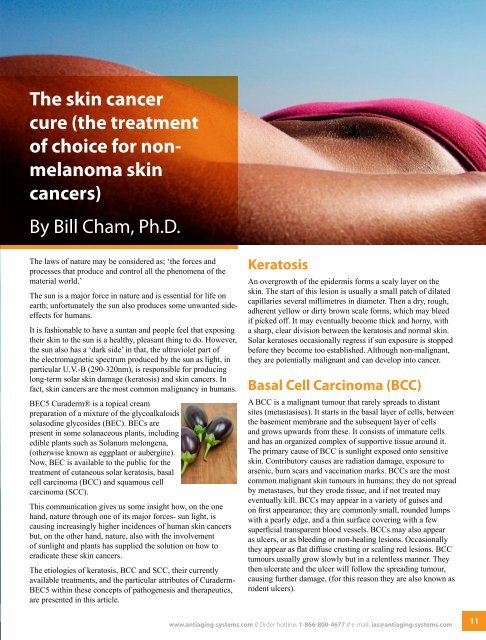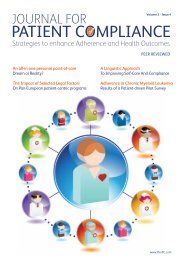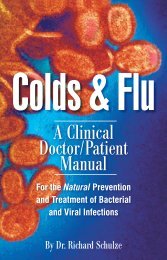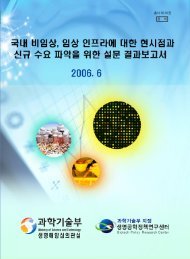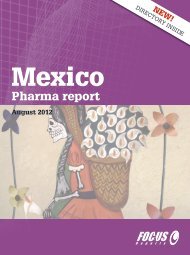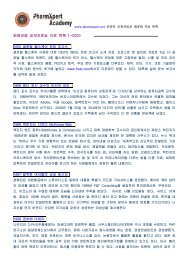Nanogen - PharmXpert Academy
Nanogen - PharmXpert Academy
Nanogen - PharmXpert Academy
You also want an ePaper? Increase the reach of your titles
YUMPU automatically turns print PDFs into web optimized ePapers that Google loves.
The skin cancer<br />
cure (the treatment<br />
of choice for nonmelanoma<br />
skin<br />
cancers)<br />
By Bill Cham, Ph.D.<br />
The laws of nature may be considered as; ‘the forces and<br />
processes that produce and control all the phenomena of the<br />
material world.’<br />
The sun is a major force in nature and is essential for life on<br />
earth; unfortunately the sun also produces some unwanted sideeffects<br />
for humans.<br />
It is fashionable to have a suntan and people feel that exposing<br />
their skin to the sun is a healthy, pleasant thing to do. However,<br />
the sun also has a ‘dark side’ in that, the ultraviolet part of<br />
the electromagnetic spectrum produced by the sun as light, in<br />
particular U.V.-B (290-320nm), is responsible for producing<br />
long-term solar skin damage (keratosis) and skin cancers. In<br />
fact, skin cancers are the most common malignancy in humans.<br />
BEC5 Curaderm® is a topical cream<br />
preparation of a mixture of the glycoalkaloids<br />
solasodine glycosides (BEC). BECs are<br />
present in some solanaceous plants, including<br />
edible plants such as Solanum melongena,<br />
(otherwise known as eggplant or aubergine).<br />
Now, BEC is available to the public for the<br />
treatment of cutaneous solar keratosis, basal<br />
cell carcinoma (BCC) and squamous cell<br />
carcinoma (SCC).<br />
This communication gives us some insight how, on the one<br />
hand, nature through one of its major forces- sun light, is<br />
causing increasingly higher incidences of human skin cancers<br />
but, on the other hand, nature, also with the involvement<br />
of sunlight and plants has supplied the solution on how to<br />
eradicate these skin cancers.<br />
The etiologies of keratosis, BCC and SCC, their currently<br />
available treatments, and the particular attributes of Curaderm-<br />
BEC5 within these concepts of pathogenesis and therapeutics,<br />
are presented in this article.<br />
Keratosis<br />
An overgrowth of the epidermis forms a scaly layer on the<br />
skin. The start of this lesion is usually a small patch of dilated<br />
capillaries several millimetres in diameter. Then a dry, rough,<br />
adherent yellow or dirty brown scale forms, which may bleed<br />
if picked off. It may eventually become thick and horny, with<br />
a sharp, clear division between the keratosis and normal skin.<br />
Solar keratoses occasionally regress if sun exposure is stopped<br />
before they become too established. Although non-malignant,<br />
they are potentially malignant and can develop into cancer.<br />
Basal Cell Carcinoma (BCC)<br />
A BCC is a malignant tumour that rarely spreads to distant<br />
sites (metastasises). It starts in the basal layer of cells, between<br />
the basement membrane and the subsequent layer of cells<br />
and grows upwards from these. It consists of immature cells<br />
and has an organized complex of supportive tissue around it.<br />
The primary cause of BCC is sunlight exposed onto sensitive<br />
skin. Contributory causes are radiation damage, exposure to<br />
arsenic, burn scars and vaccination marks. BCCs are the most<br />
common malignant skin tumours in humans; they do not spread<br />
by metastases, but they erode tissue, and if not treated may<br />
eventually kill. BCCs may appear in a variety of guises and<br />
on first appearance; they are commonly small, rounded lumps<br />
with a pearly edge, and a thin surface covering with a few<br />
superficial transparent blood vessels. BCCs may also appear<br />
as ulcers, or as bleeding or non-healing lesions. Occasionally<br />
they appear as flat diffuse crusting or scaling red lesions. BCC<br />
tumours usually grow slowly but in a relentless manner. They<br />
then ulcerate and the ulcer will follow the spreading tumour,<br />
causing further damage, (for this reason they are also known as<br />
rodent ulcers).<br />
www.antiaging-systems.com // Order hotline: 1-866-800-4677 // e-mail: ias@antiaging-systems.com<br />
11


